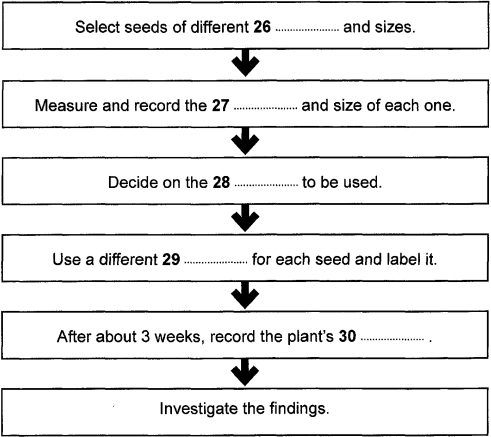

[00:59.52]EMMA:We’ve got to choose a topic for our experiment.Haven’t we, Jack?
[01:03.90]Were you thinking of something to do with seeds?
[01:06.96]JACK:That’s right.
[01:08.24]I thought we could look at seed germination--- how a seed begins to grow.
[01:13.70]EMMA:Ok. Any particular reason?
[01:16.82]I know you’re hoping to work in plant science eventually…
[01:20.45]JACK:Yeah, but practically everything we do is going to feed into that.
[01:25.08]No, there’s an optional module on seed structure and function in the third year that I might do,so I thought it might be useful for that.
[01:35.26]If I choose that option, I don’t have to do with dissertation module.
[01:40.58]EMMA:Good idea.
[01:41.55]JACK:Well, I thought for this experiment we could look at the relationship between seed size and the way the seeds are planted.
[01:51.02]So, we could plant different sized seeds in different ways, and see which grow best.
[01:57.42]EMMA:Ok. We need to allow time for the seeds to come up.
[02:01.93]JACK:That should be fine if we start now.
[02:04.95]A lot of the other possible experiments need quite a bit longer.
[02:09.60]EMMA:So that’d make it a good one to choose.
[02:12.81]And I don’t suppose it’d need much equipment; we‘re not doing chemical analysis or anything.
[02:19.75]Though that’s not really an issue, we’ve got plenty of equipment in the laboratory.
[02:25.18]JACK:Yeah, we need to have a word with the tutor if we’re going to go ahead with it though. I’m sure our aim’s OK.
[02:33.19]It’s not very ambitious but the assignment’s only ten percent of our final mark, isn’t it?
[02:39.97]But we need to be sure we’re the only ones doing it.
[02:44.65]EMMA:Yeah, it’s only 5 percent actually, but it’d be a bit boring if everyone was doing it.
[02:52.01]JACK:Did you read that book on seed germination on our reading list?
[02:56.42]EMMA:The one by Graves?
[02:57.77]I looked through it for my last experiment, though it wasn’t all that relevant there.
[03:03.67]It would be for this experiment, though.
[03:06.28]I found it quite hard to follow---lots about the theory, which I hadn’t expected.
[03:12.56]JACK:Yes, I’d been hoping for something more practical.
[03:16.24]It does include references to the recent findings on genetically-modified seeds, though.
[03:22.56]EMMA:Yes, that was interesting.
[03:24.57]JACK:I’ve read an article about seed germination by Lee Hall.
[03:28.68]EMMA:About seeds that lie in the ground for ages and only germinate after a fire?
[03:34.81]JACK:That’s the one. I knew a bit about it already, but not about this research.
[03:40.78]His analysis of figures comparing the times of the fires and the proportion of seeds that germinated was done in a lot of detail---very impressive.
[03:52.40]EMMA:Was that the article with the illustrations of early stages of plant development?
[03:58.12]They were very clear.
[03:59.77]JACK:I think those diagrams were in another article.
[04:44.65]EMMA:Anyway, shall we have a look at the procedure of our experiment?
[04:49.49]We’ll need to get going with it quite soon.
[04:51.88]JACK:Right.
[04:52.67]So the first thing we have to do is to find our seeds.
[04:57.54]I think vegetable seeds would be best.
[05:00.73]And obviously they mustn’t all be the same size.
[05:04.70]So, how many sorts do we need?
[05:07.80]About four different ones?
[05:10.16]EMMA:I think that would be enough.
[05:12.06]There would be quite a large number of seeds for each one.
[05:15.20]JACK:Then, for each seed we need to find out how much it weighs, and also measure its dimensions, and we need to keep a careful record of all that.
[05:26.76]EMMA:That’ll be quite time-consuming.
[05:29.35]And we also need to decide how deep we’re going to plant the seeds--- right on the surface, a few millimeters down, or several centimeters.
[05:38.90]JACK:Ok.So then we get planting.
[05:41.79]Do you think we can plant several seeds together in the same plant pot?
[05:47.11]EMMA:No, I think we need a different one for each seed.
[05:51.51]JACK:Right.
[05:52.84]And we’ll need to label them---we can use different coloured labels.
[05:57.68]Then we wait for the seeds to germinate--- I reckon that’ll be about three weeks, depending on what the weather’s like.
[06:05.99]Then we see if our plants have come up, and write down how tall they’ve grown.
[06:11.83]EMMA:Then all we have to do is look at our numbers, and see if there’s any relation between them.
[06:16.82]JACK:That’s right.So…
Complete the flow-chart below.
Stages in the experiment

26
27
28
29
30

名师1对1,深度分析薄弱项,高效提分
(剑雅1-16可直接使用)
扫码添加助教微信
回复关键词“解锁真题”
即可免费解锁!